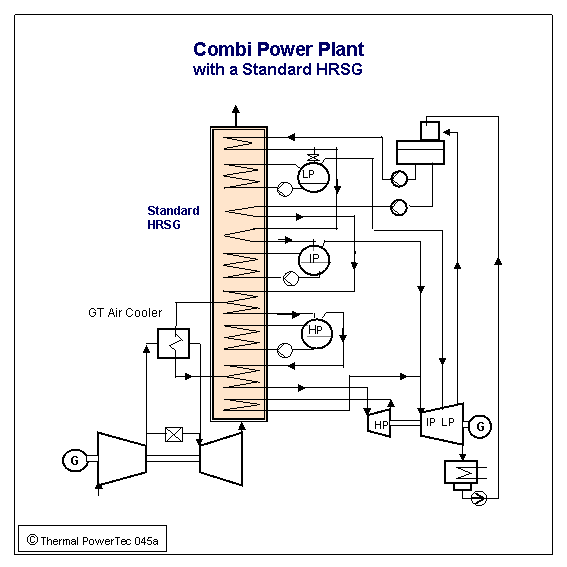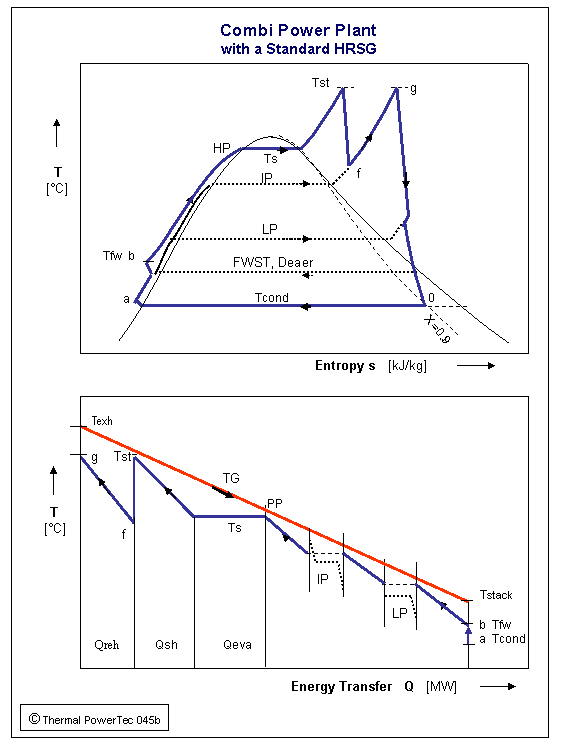Gas and Steam Turbine Power Plants
New Procedure for Increase of Efficiency & Powerdeveloped by TPT
Combined Cycles Power Plant CCPP
Today the CCPP is the most used power plants. CCPPs use a combination of two thermodynamic cycles: the gas turbine cycle (Brayton cycle) operating in a high-temperature and the steam turbine cycle (Rankine cycle) in a low-temperature range by using steam production in a heat recovery steam generator (HRSG). The combined cycle concept exploit the high-temperature potential of modern gas turbines and the low-temperature (cold end) of the steam cycle.
The combined cycle power plant offers high thermal efficiency, low emissions, low installed cost, flexibility in fuel selection and low operation and maintenance cost.
CCPPs are suitable for daily cycling operation due to short start-up times and for continuous base load operation. Part load efficiencies are also high due to the control of the gas turbine inlet mass flow using inlet adjustable vanes.
The fuel flexibility of CCPP in limited to gases and some oils. The fuels that can be fired are those which are widely available in most parts of the world.
The main differences between combined cycle steam turbines and conventional steam turbines are:
- fewer or even no steam extractions for the feed water heating
- shorter start-up times
- lower live-steam pressures, 100 to 160 bar (160 to 300 bar by STPP)
Today the net thermal efficiency of the combined cycles power plants lie between 0.56 and 0.59. The losses by the exhaust gases and condensation of the exhaust steam are still relative high and lie between 40% and 43% of the supplied heat flow.
Research and the Development by Thermal PowerTec Ltd:
The research and the development of the water-steam cycle of combined power plants led to a new procedure for the reduction of exhaust steam losses and increase of thermal efficiency:
New Procedure 1:
"A new combined cycles power plant with a single-supercritical-pressure HRSG"
EP Ablication : April 2010
Inventor : Dr. Mustafa Youssef
Applicant: Thermal PowerTec Ltd, Zürich (CH)
The invention concerns a procedure to increase the thermal efficiency of gas and steam turbine power plants and especially of natural-gas combined-cycle. The gas turbine is combined with a single-supercritical-pressure HRSG. The live steam with a supercritical pressure expands by the HP steam turbine without a reheating to a wet steam state in the water steam zone below the water-steam boundary line. The steam wetness is removed by the moisture seperator and the LP evaporator.
A part of the separated condensate is led to the feed water. The saturated LP steam is reheated by the LP reheater and expands by the LP turbine to the condenser pressure.
Fig. 50a shows a single-supercritical-pressure used in HRSG.
Fig. 50b shows a temperature-entropy-diagram of the new process.
Fig. 50b shows a TQ-diagram for the energy transfer between gas and water-steam.
Compared to today's best combined cycle power plants with a triple-pressure HRSG and a steam reheating the new procedure allows an increase of the thermal efficiency of around 1%.
The thermal efficiency rises from for example 59% to over 60% and the output gain of the plant amounts to approximately 2%.
For the same electrical output of a CCPP this more environment friendly invention leads both to a reduction of the heat emissions of around 3% and to a reduction of the exhaust gas (CO2 and NOx) of around 2% into the environment.
Procedure 2:
"Procedure for increase the output and the thermal
efficiency of the combined cycles power plants"
Publication Nr. EP 1 808 588, Date: 18.07.2007 Publication: pdf-fileEP 1808588
Inventor: Youssef Mustafa (CH)
Applicant: Thermal PowerTec Ltd, Zürich (CH)
The research and the development of the gas turbine and steam turbine cycles led to a new procedure for the reduction of exhaust steam and exhaust gas losses below the 40% of the supplied heat flow.
In the gas turbine the supplied heat flow is increased by reducing the pressure of the 2. sequential combustion and the exhaust gas temperature is reduced by the gas expansion into the vacuum range. These make possible in the steam generator the use of a Single-pressure cycle with low exhaust gas temperature, in order to achieve minimum exhaust steam and exhaust gas losses. Thus the thermal efficiency of the combined cycles plant can be increased by more than 0.02 (i.e. hth net >0.60) and the power output by more than 18%.
In the gas turbine with vacuum expansion and sequential combustions the pressure of the LP combustion is reduced. The LP cooling air of the gas turbine taken from the air compressor by the corresbond pressure has a lower temperature and can be used, without cooling down. So only one gas turbine air cooler (HP air cooler) is necessary.
Construction of a CCPP with a vacuum gas turbine expansionin order to benefit from the present new procedure the use of the vacuum gas turbine expansion can be implemented without a large expenditure. All necessary elements (vacuum gas turbine stage, gas compressor and gas cooling in a vacuum container) are usual not complex parts in the power plant technology.
The following three options are possible:
Repowering of Existing CCPPs: CCPPs can repowered purely in order to benefit from the increase of efficiency and power output even though they are far from the end of their design life. Repowering an existing CCPP is possible and can be achieved by supplement of a vacuum gas turbine stage and a gas compressor and by changing a part of the HRSG.
Expected profits in a 300 MW CCPP:a) A power increase of 16% respectively 48 MW is expected. This can be evaluated with approx. 30 mil $. These will exceed the construction costs to a large extent.
b) The increase of the thermal efficiency of 2 per cent points results for a power increase of approx. 10 MW without fuel cost. This can be evaluated with approx. 1.8 mil $/year.
Gas Turbine Cooling The increasing of the hot gas temperature on the inlet of the gas turbine increases the efficiency of the gas turbine and thus of the CCPP. The problem of the gas turbine is particularly in the high temperature of the turbine blades. In order to bear the usual temperatures of 1000 to 1200°C, apart from the use of developed materials the turbine components are cooled additionally from the inside, by compressed and cooled cooling air.
Open Loop Air Cooling
For this open cooling a part of the compressed air is removed on different pressure levels from the compressor and used for the cooling of combustion chamber and turbine blades. The extracted cooling air must be cooled down, before it used as cooling air in the turbine. After cooling of turbine components the cooling air is mixed in the turbine with the main gas flow.
Several concepts are available for matching the cooling requirements to the CCPP.
Open cooling concepts can be used for cooling the compressed cooling air:
- Water injection (quench cooler)
- Steam injection
- Water-Steam cooling in heat exchangers
For avoiding the loss of demineralised make-up water and the loss of evaporating heat energy in the exhaust gas, the use of water-steam-cycle for the air cooling in CCPP is the most economical solution.
GT-Air Cooler (Air/Water-Steam Heat Exchanger):
The air/water-steam cooler works as a steam generator. The cooling water is supplied from the feed water of the steam turbine cycle. In the gas turbine cooler the water is evaporated, superheated and return to the steam cycle.
The air/water-steam cooler has limitations of operation range. For a given bundle geometry the limitations depends on ambient temperature and inlet temperature/pressure of cooling water.
For more information on Air/Water-Steam GT-Cooler see:
"AIR COOLER FOR POWER STATION PLANT AND USE OF SUCH AN AIR COOLER"
Inventor: YOUSSEF MUSTAFA (CH)
Applicant: ALSTOM TECHNOLOGY LTD (CH)
EP 1590603: GT Cooler
Closed-loop steam cooling
This steam cooling system permits the higher firing temperatures required for increased efficiency. Gas turbine cooling steam is supplied from the steam turbine cycle. The steam cools the gas turbine and return to the steam cycle. The closed loop steam cooling is in the development.
GE Power Systems developed the closed loop steam cooling (H System). The GE's H System permits the higher firing temperatures and designed with the capability to achieve 60% thermal efficiency.
The gas turbine cooling system is integrated with the steam cycle. The supply of cooling steam is from HP steam turbine exhaust. The steam is delivered to the gas turbine stationary parts through casing connections and to the rotor through a conventional gland connection. The cooling steam is returned to the steam cycle at the reheat line.
If the gas turbine steam cooling (H System) of GE Power Systems and the gas turbine vacuum expansion of TPT used in a combined cycle plant, then a net thermal efficiency of over 62% is expected.










Tidak ada komentar:
Posting Komentar